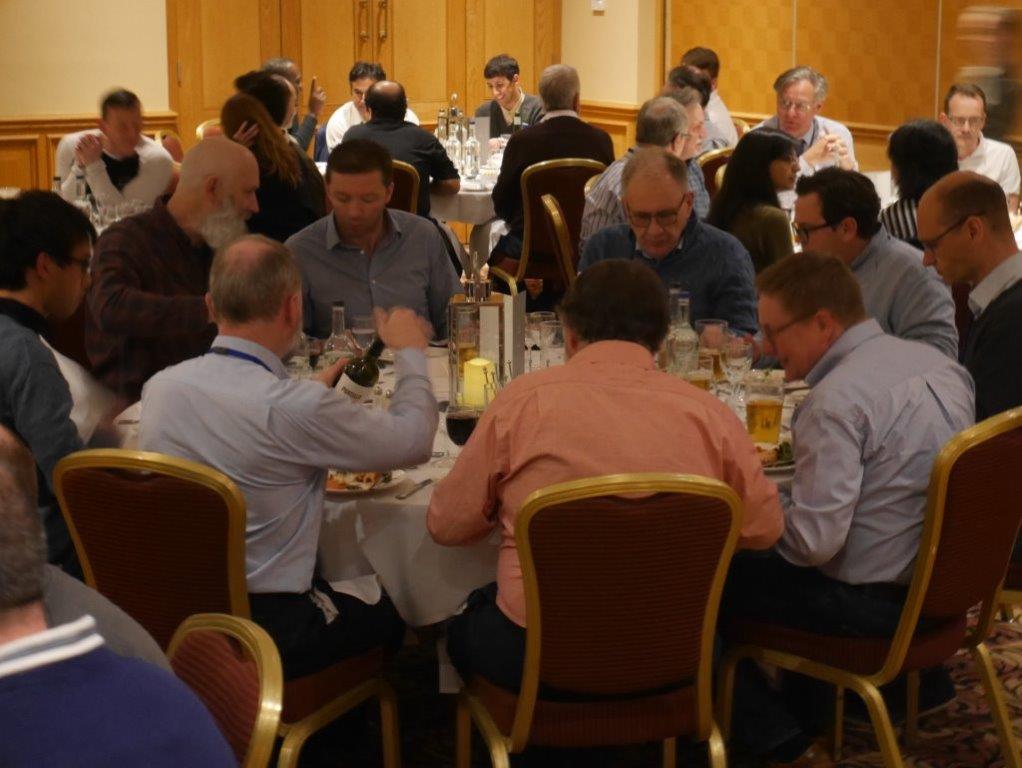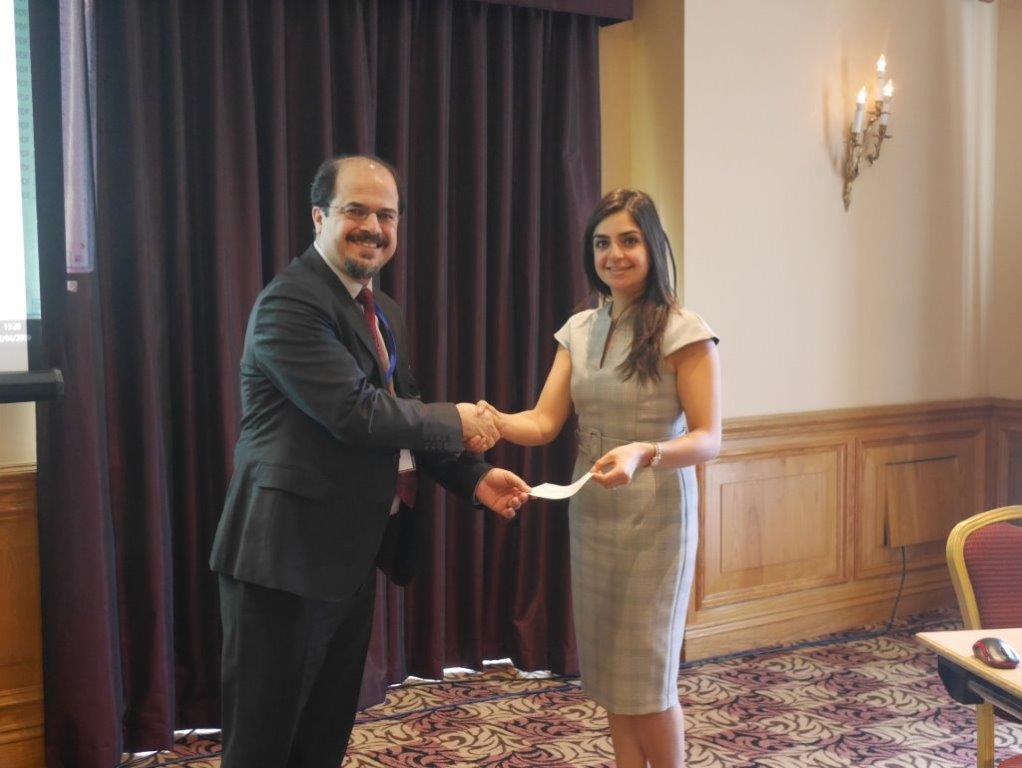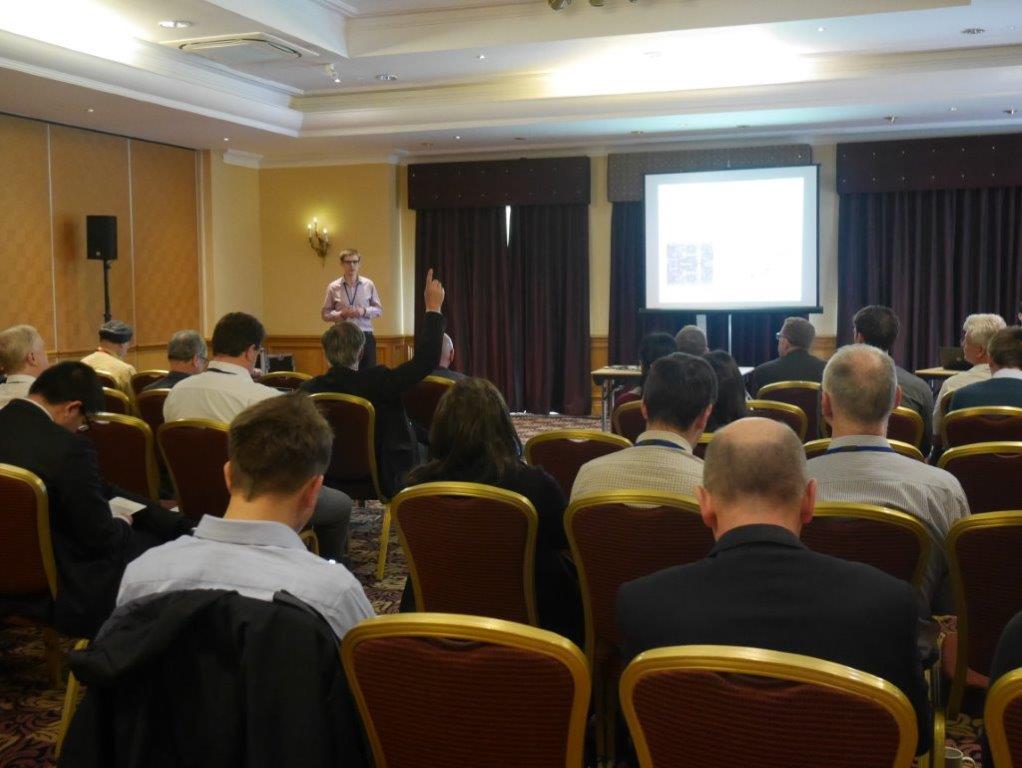Young Engineer Sponsorship: The ARMMS RF & Microwave Society provides sponsorship for young engineers (28 or below) who have had papers accepted for presentation at each meeting. Sponsorship is £200 cash plus free attendance (including conference dinner and overnight accommodation). Jonathan Rawlinson of Surrey Satellite Technology and Diviya Devani of Teledyne E2V were sponsored to attend the April 2019 meeting. Potential candidates should identify themselves as eligible at time of submission and state their date of birth. This offer is limited to a maximum of 2 places per meeting.
Best Paper Award: The Steve Evans-Pughe prize is awarded to the best presenter at each meeting. The award is £200 for the best paper and £50 for the runner-up. The prize is sponsored by NI. Mohsin Haji of NPL won the April 2019 award, the runner-up was iviya Devani of Teledyne E2V.
For exhibition enquiries please email exhibition@armms.org, for all other enquiries please email enquiries@armms.org
 |  |  |
Double Tree by Hilton Oxford Belfry
Thame
OX9 2JW
| Web | https://doubletree3.hilton.com/en/index.html |
Kara (Mehmet Karaaslan)
Technical Specialist
Teledyne e2v
5G Base Station Antenna Design | |
| Korkut Yegin | |
| Ege University | |
Base station antenna requirements for 5G demand high gain, wide beamwidth and low reflection coefficient antenna structures. A slot-fed waveguide antenna with stepped opening is proposed to satisfy all these requirements. The design and simulations of the antenna are carried out in CST Microwave Studio and impedance bandwidth (RL< -15 dB) and element gain greater than 14 dBi are obtained. The structure, although inspired from open-ended waveguide, exhibits low gain variation and stable beamwidth over 24.5 GHz to 28.5 GHz. The antenna has dual linear slant polarizations with +45° and -45°. Theoretical analysis, simulation details and prototype measurements will be provided. | |
| 5G Base Station Antenna Design | |
A coherent, multichannel signal generator for a 5G mmWave antenna test-bed | |
| Tim Masson | |
| Keysight Technologies | |
The paper will describe the design (a bit) and implementation (a bit more) of a 2-channel generator based on up-conversion of a directly synthesized IF. By taking a totally different approach we were able to deliver a system that met the basic requirements for the target system at significantly lower cost than using the obvious IQ Baseband – Vector Generator combination. Nothing come for free – so I will touch on some of the trade-offs of this approach, and some possible enhancements, should we do another similar system in future. | |
| A coherent, multichannel signal generator for a 5G mmWave antenna test-bed | |
A Fully Integrated 3.5GHz Single chip GaN Doherty PA for sub-6GHz 5G | |
| Robert Smith | |
| Plextek RFI | |
The presentation will describe a fully integrated Doherty MMIC for the 3.5GHz 5G band designed by Plextek RFI (now PRFI). The PA was fabricated on a 0.4µm gate length GaN-on-SiC process from GCS. The MMIC is packaged in a laminate SMT QFN. This presentation will outline the design, manufacture and evaluation of the PA and demonstrate good agreement between measurement and simulation. The design process was de-risked using PRFI's MMIC design verification process. The packaged MMIC was evaluated on a representative PCB. Measurements included evaluation using a 100MHz 5G NR signal at 3.5GHz. The packaged PA achieved a PSAT of 45dBm with a peak PAE of 50%. The PAE at 8dB power back-off was 31.5%. Using a 100MHz signal with 11.5dB PAPR the EVM was 3.5% and ACLR was less than -33dBc at an average power of 36dBm (4W). | |
| A Fully Integrated 3.5GHz Single chip GaN Doherty PA for sub-6GHz 5G | |
A GaAs SP8T Switch Design for E-Band Automotive Radar | |
| Priya Shingal | |
| Arralis Technologies | |
A GaAs Single Pole Eight Throw (SP8T) switch design, simulation and measured performance in a frequency range of 76-81 GHz is discussed. The switch is intended to be used in the RF-frontend design of an E-band FMCW automotive Radar system. UMS foundry’s Schottky diode process is used for the design and fabrication as it exhibits very low junction capacitance and series resistance for the diode. On-wafer measured insertion loss and isolation of the designed SP8T is <6 dB and >24.9 dB respectively from 76-81 GHz. On-wafer measured input and output return losses are >10 and 12 dB respectively both in open condition and when one switching arm is closed. The paper discusses the design technique for a multi-throw switch at such high frequencies where phase imbalance in the switching arms poses limitations. Use of a SP8T switch would reduce a number of transition losses as compared to if either SPDT or SP4T were used, specifically at such high frequencies. Assembly related costs and losses are also reduced due to the reduced number of chips being used. Hence, overall system performance is improved which is critical at such frequency range and for the application. | |
| A GaAs SP8T Switch Design for E-Band Automotive Radar | |
Ambient Radio Frequency Energy Harvesting - A Load of Hot Air? | |
| Gavin Watkins | |
| Toshiba Research | |
Ambient Radio Frequency (RF) Energy Harvesting (EH) is touted by some as a source of free energy for powering anything from Internet of Things (IoT) sensor nodes to charging mobile phones. Many start-ups have received significant funding pursuing this goal. To evaluate the feasibility of harvested RF power from radio transmissions, measurements were undertaken in Bristol, UK, in the spectrum between 500MHz and 6GHz, a band that includes TV broadcast, mobile phones, radar and Wi-Fi. | |
| Ambient Radio Frequency Energy Harvesting - A Load of Hot Air? | |
Class BJF-1: Simplifying the design methodology of RF Power amplifiers | |
| Merlyne De Souza | |
| University of Sheffield | |
We present Class BJF-1, a new class of amplifier that achieves efficiencies higher than class B/J/J* for a large range of possible load impedances that considerably simplifies the design space. The formulation for this class encompasses Class J (High linearity), CCF-1 (high efficiency), extended CCF-1, and saturated PAs. We can choose better amongst this range to achieve the desired target performance. Three PA prototypes were designed by selecting impedances within the design space. All three fabricated amplifiers using a GaN HEMT CGH40010F achieved measured PAE in excess of 72%, and saturated output power Pout in excess of 41 dBm. The measured P1dB ranged from 30 dBm to 35 dBm, as chosen by design. Moreover, a 3dB bandwidth of 800 MHz was observed, despite using only narrowband techniques. This is because of the large design space coupled with a simple strategy of an impedance transformer in the matching network. The best performing amplifier achieved 79.7% drain efficiency and 42.2 dBm saturated output power at 2.6 GHz, giving a frequency weighted efficiency (FE= (average efficiency)*?Center Freq) of 92.4%?GHz, representing one of the highest figures of merit achieved with this device reported to date. | |
| Class BJF-1: Simplifying the design methodology of RF Power amplifiers | |
Demonstrating Multi-Constellation GNSS Reflectometry Using TechDemoSat-1 | |
| Jonathan Rawlinson | |
| Surrey Satellite Technology Ltd | |
GNSS-R (Global Navigation Satellite System Reflectometry) is a novel technique for making measurements of the Earth’s surface using L-Band signal reflections from GNSS constellations, such as GPS, Galileo, Glonass and Beidou. In 2014, SSTL (Surrey Satellite Technology Ltd) launched the UK TechDemoSat-1 satellite with 8 payloads including the SGR-ReSI, a low cost and low power GNSS-R instrument. This payload has been in operation since commissioning in September 2014 and has been collecting reflection data for scientific use since. The primary application is ocean wind and wave retrieval, but reflections have also been recovered over land and ice, uncovering new applications for this technique. This paper describes the practicalities of GNSS-R, the current and proposed future usage, new developments and planned future work by SSTL in this area, including the first results from the recovery of Galileo signal reflections. | |
| Demonstrating Multi-Constellation GNSS Reflectometry Using TechDemoSat-1 | |
Design of a 5W GaN MMIC power amplifier for Ka-band application | |
| Jonathan Leckey | |
| Iconic RF Ltd | |
The design of a 26-31GHZ 5W GaN on SiC MMIC for 5G and Satcomms application is presented. The design flow is based on characterisation of unit cells using a Focus Microwaves active load pull system to produce a Cardiff type behavioural model, together with a compact equation based model derived from pulsed IV and S-parameter measurements. A comparison of the behavioural vs compact model approach and their complementary use in a new PA design flow is described. Measured PA results show the effectiveness of the approach with 4W Psat obtained across 26-30GHz with PAE>25%. | |
| Design of a 5W GaN MMIC power amplifier for Ka-band application | |
Designing Wideband Filters Having More Than 3 Octave Bandwidth | |
| Bulent Alicioglu | |
| Broadcom, Germany | |
Designing very wideband filters remains still a challenge for most of the cases even today. The suspended substrate stripline is still the ultimate choice for sharp filters with low loss. In this work a step by step approach will be presented for practical wideband filter design. The method/procedure will be verified through a 2 GHz HPF with a passband up to 18 GHz and measurement results will be presented. | |
| Designing Wideband Filters Having More Than 3 Octave Bandwidth | |
Mechanical Design Techniques for maximizing PCB space and reducing system size and weight | |
| Jeff Davis | |
| Tennmax America Inc | |
Traditionally high frequency applications have used metal multi-cavity clamshell shields screwed down to the PCB. To minimize the gaps, they would either place screws a few cm apart or place an extruded gasket on the walls and move the screws farther apart. Both solutions require a wide PCB trace and excessive bosses that increase the weight of the metal and uses excessive amount of PCB space. There are techniques that can reduce the amount of screws needed, while thinning the walls which will provide both weight reduction and width of the PCB traces (as low as 0.5mm). Another key item for reducing overall system size and weight is the removal of heat. Metal is the only reasonable method for removing heat, but by using design techniques such as heat pipes or vapor chambers, you can increase the efficiency of the heat transfer which will allow you to reduce the overall fin and metal size. You can quite often add the gaskets to the bottom of the thermal module to provide a single part for both heat and shielding with a single part. | |
| Mechanical Design Techniques for maximizing PCB space and reducing system size and weight | |
Microwave Atomic Clocks at NPL | |
| Mohsin Haji | |
| NPL | |
Microwave atomic clocks can establish highly stable reference frequencies by using the exact frequency of microwave spectral lines of atoms. Caesium, for example, has hyperfine ground state lines that are separated by a frequency of 9,192,631,770 Hz, and this currently provides the fundamental unit of time (a second). The NPL caesium fountain primary frequency standard NPL-CsF1 is a type of microwave atomic clock used to contribute to the international timescale. Microwave interrogation of atoms can also be used to form portable atomic clock systems. NPL have recently developed a prototype for a benchtop portable atomic clock system using ytterbium-ions, as well as a much more compact caesium based atomic clock, designed to fit in an enclosure of ~600 cm3. These systems will be described in more detail. | |
Mm-wave/THz Multi-Gigabit Wireless Links | |
| Edward Wasige | |
| University of Glasgow | |
The demand for broadband content and services worldwide is growing at a tremendous pace. Soon, traffic from wireless devices will exceed that of wired setups. Currently, high-resolution videos account for about 69 % of all data viewed on mobile devices and are expected to reach 79 % by 2020. At this pace, short-range wireless communication will soon require data transfer speeds of tens of gigabits per second (Gbps), which current wireless technology cannot support. A host of technologies are being actively researched to meet this challenge. In this talk, we will describe our research on the resonant tunnelling diode (RTD) technology to create ultra-broadband wireless communications. RTDs are compact, high-speed semiconductor devices that can function as transmitters and receivers. They can be modulated using electronic or optical signals and can also be used to modulate lasers. This makes them potentially valuable as a link between fibre and wireless domains. We will report on short range wireless links with data rates of over 10 Gbps using new RTD transmitters developed for the 100 GHz and 300 GHz regions of the radio spectrum. These speeds are over 1 000 times faster than the rates available at the moment. | |
| Mm-wave/THz Multi-Gigabit Wireless Links | |
RFSoC & Python Integration and Higher Levels of Abstraction | |
| Adam Taylor | |
| Lincoln DSP | |
This paper will present the Xilinx RFSoC the benefits of integration and how it can be developed using Python to accelerate the development of RF solutions using heterogeneous SoC solutions which include Processors, Logic and Multi Gigasample DAC and ADC. | |
| RFSoC & Python Integration and Higher Levels of Abstraction | |
The Quantum World: From Laboratory to Industry | |
| Diviya Devani | |
| Teledyne E2V | |
Recent advancements in quantum technology mean we can exploit the fundamental properties of atoms and particles and apply quantum mechanics to real world applications. Some of the applications Teledyne e2v are focussing on include quantum sensors for civil engineering and oil and gas, space based quantum sensors with applications in Earth observation and quantum clocks for navigation and timekeeping resilience. Quantum sensors offer advantages to existing technologies such as ground penetrating radar which are used to map under the ground. Similarly quantum clocks offer benefits to existing technology. This talk will give an overview of quantum technologies being commercialised at Teledyne e2v, an insight into how RF and microwave frequencies are used in the devices being developed and a comparison to existing technologies. | |
| The Quantum World: From Laboratory to Industry | |
Time resolved Raman thermography analysis of transient heating in pulsed GaN HEMT RF high power transistors | |
| Filip Gucmann | |
| University of Bristol | |
Measurement is a vital step in thermal model verification. We present a static/transient measurement and simulation study of a GaN high power pulsed transistor. Time resolved Raman thermography provides high spatial (0.5 µm-lateral) and temporal resolution (>10ns), enabling the temperature within the GaN, close to the channel peak temperature, to be measured. This technique is therefore an ideal reference measurement technique for GaN HEMTs which generate high temperature gradients close to the gate. We demonstrate this process of thermal model verification. Complimentary transient thermo-reflectance measurements are also performed on the field plate metal surface for comparison. The resulting experimentally validated finite element thermal simulation is used to derive a thermal equivalent circuit model, representing the thermal impedance (ZTH) of the tested device. | |
| Time resolved Raman thermography analysis of transient heating in pulsed GaN HEMT RF high power transistors | |
Companies booking two or more delegate places are able to take part in the commercial exhibition that accompanies the conference. Please note: there is a maximum of 20 exhibition tables at each meeting, these are offered on a first come basis. Booking two delegate places does not guarantee an exhibition space, please email exhibition@armms.org to check availability and reserve and exhibition space.
The society would like to thank Wolfspeed for sponsoring in April 2019 meeting:
Contributions are invited with an emphasis on RF and microwave design, research, testing and associated subjects. An oral presentation will be made at the meeting and a written paper will be required for publication in the society digest, which is distributed to delegates at the meeting. Prospective speakers are requested to submit a title and a short abstract to the technical coordinator (see above) as soon as possible.
Click here to view our Guidelines for Authors
Click here to view our Publication Release Form